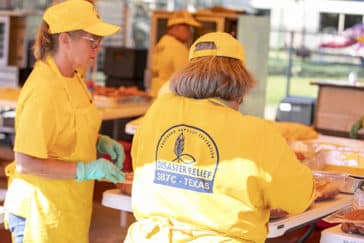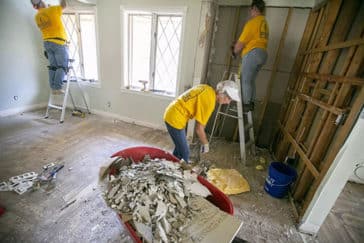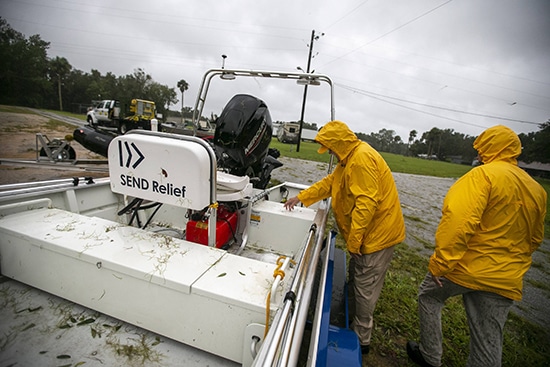Rob Heath of Edisto Island had a lot to do on Sept. 29 as he prepared for Hurricane Ian with direct knowledge of the unfortunate timing of its arrival to the South Carolina coast.
“We’re hearing that it may get here around midday tomorrow (Sept. 30),” he told Baptist Press as another weather alert went off on his phone. “That’s going to coordinate with high tide, which unfortunately, is a little bit higher now because of the moon phase.”
Heath, pastor of Redeemer Fellowship Church, is like many who live on Edisto Island. He’s not technically from there, but lived for 40 years with his wife, Vicki, in nearby Charleston, serving as a pastor for about 25 years.
Edisto Island is one of South Carolina’s Sea Islands, with a maximum elevation of eight feet. It is accessible by only one bridge, located on its north side.
“We’re checking on everyone and seeing who needs rides [out],” Heath said. “I’m also keeping in touch with the town to let them know who is staying for any help we can provide afterwards.”
Further up the coast, First Baptist, Charleston, canceled activities through Saturday.
“We have secured our campus and are preparing for cleanup once the storm passes,” Pastor Marshall Blalock told Baptist Press before the storm came ashore near Georgetown. “We continue to pray for our friends in Florida who suffered the worst of the hurricane.”
As South Carolina’s coastal residents braced for the storm’s strike on Friday, Floridians were grappling with the magnitude of Hurricane Ian’s devastating blow to their state.

Southern Baptist Convention Texas Disaster Relief volunteers prepare meals at McGregor Baptist Church in Fort Myers , Fla., on Tuesday, Oct. 4, after Hurricane Ian. Disaster relief teams are providing food and other rescue help across the communities affected by the hurricane last week. (Alan Youngblood/Send Relief)
Ian made landfall Sept. 28 in the Punta Gorda/Cape Coral area as a Category 4 hurricane with sustained winds of 145 mph. A “catastrophic” storm surge, winds and flooding came with it, the National Weather Service said.
Losing strength as it passed over land, Ian was eventually downgraded to a tropical storm prior to its emergence over the Atlantic, at which point it gathered strength again. That led to a hurricane warning issued at 10 a.m. on Thursday for the South Carolina coast.
“Landfall will coincide with high tide, which will make the storm surge even worse,” said Susan Peugh, disaster relief director for the South Carolina Baptist Convention, as Ian approached.
Weather officials had predicted the South Carolina coast still could see storm surge of four to seven feet and considerable rainfall.
“We are already receiving reports of downed trees,” Peugh said, even before the storm made landfall. “Because this will affect the entire state, we have put all of our units on standby.”
Meanwhile, in Florida, media outlets were using words like “staggering” and “overwhelming” to describe the intensity and vastness of the destruction Hurricane Ian left in its wake. In a media briefing Sept. 29, Florida Gov. Ron DeSantis said the state had never seen a flood event of this magnitude.

Disaster Relief volunteers clean out a home in Fort Myers, Fla., after Hurricane Ian brought four feet of water inside. (Send Relief photo by Alan Youngblood)
In describing damage to Sanibel Island, DeSantis told reporters, “It got hit with really biblical storm surge.”
A reported 1.9 million Floridians were without electricity Friday morning, with thousands of linemen deploying up and down the coast and throughout the state.
Southern Baptist Disaster Relief volunteers coming from out of state made their way to Florida Friday, with many arriving and setting up over the weekend. Florida SBDR leaders and volunteers, who staged people and equipment in Leesburg, were ready to move into hard-hit areas as soon as officials complete search and rescue efforts.
Some South Carolina Disaster Relief units are serving now in Arcadia, Fla., at a response site managed by Alabama DR leaders. Other S.C. units will be assigned to other places, yet to be determined.

Send Relief team member Jamie Elkins loads disaster relief supplies headed for Florida at Send Relief’s ministry center in Ashland, Ky. The items and emergency supplies will be used by state Disaster Relief units as they serve Hurricane Ian survivors. (Photo provided by Send Relief)
A Send Relief truck loaded with supplies — including bottled water, tarping for rooftops, and Shockwave treatment to disinfect and kill mold in flooded homes — left for Florida Friday morning. Send Relief, the Southern Baptist compassion ministry that is a cooperative effort between the North American Mission Board and the International Mission Board, will send more supplies as needed throughout the response.
“Southern Baptists have established locations for seven kitchens and the potential for three more, bringing our daily meal capacity to 170,000 if that much is needed,” said Coy Webb, Send Relief’s crisis response director.
Webb, who led disaster relief efforts for the Kentucky Baptist Convention for 15 years, said kitchen sites were active by Monday evening and will continue as long as needed. Southern Baptist recovery teams that can place tarps on rooftops, remove debris from yards and cut down storm-damaged trees, moved in shortly after that. Mud-out teams will also be needed, and that activity will begin as soon as homes can be assessed and jobs coordinated with local officials.
Text the word “Ian” to 888123 for more information or to donate to Send Relief Hurricane Ian relief efforts, or visit sendrelief.org.
— Compiled from reporting by Scott Barkley, national correspondent for Baptist Press, and Mike Ebert of the North American Mission Board.
